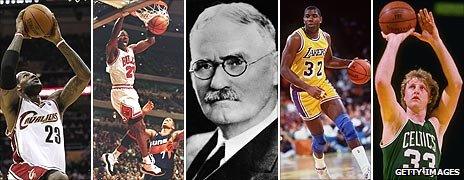The Canadian who invented basketball
-
Published

When Dr James Naismith invented basketball in 1891, he couldn't have dreamed that the game would become the world's second most popular sport, played in more than 200 countries, and a multi-billion dollar industry. Now his Canadian hometown is set to honour him with a statue.
The monument in the city where James Naismith invented basketball, in Springfield, Massachusetts, is the 40,000 sq ft Naismith Memorial Basketball Hall of Fame.
The museum in his hometown of Almonte, Ontario, is, well, rather more compact.
A large boulder - the "Rock" - stands like an altar at the heart of the museum.
It's a tribute to the inspiration for James Naismith's invention - "Duck on a Rock" - a game he played growing up.
Nine-year-old Warner Giles demonstrates the game by lobbing a rock in a familiar overhand arcing motion - knocking a stone, or "duck", off the boulder.
This was the type of throw that brought the world basketball.
Born in 1861, Dr Naismith's early life was marked by tragedy. His farmer parents died of typhoid, and he and his siblings were raised by an uncle who instilled in them the values of hard work, self reliance and determination.
Athletic prowess
A high school drop-out who worked as a lumberjack, Dr Naismith later embraced education with enthusiasm. He obtained a degree in physical education from Montreal's McGill University, a diploma in theology and - after moving to the US - qualified as a medical doctor.
He demonstrated great athletic prowess as a star football player and gymnast while at McGill, rising to became the university's first director of athletics. He was even credited later, by some, with having invented the forerunner of the football helmet.
A deeply religious man, Dr Naismith believed that sport "could be used to lead young men to a good end".
In the winter of 1891 after moving to Springfield, Dr Naismith was faced with a challenging class of "incorrigibles". This antagonistic group had to be kept fit indoors through a harsh New England winter.
After failing to occupy the men with popular indoor sports of the day, he turned to "duck on the rock" for inspiration.
Instead of a rock, the players would throw a soccer ball at two peach baskets nailed high up at each end of the gymnasium. The janitor later punched holes in the bottom of the baskets after he became tired of climbing up to retrieve balls.
The first game - comprising two teams of nine - took place on 21 December 1891. The final score was 1-0.
As Dr Naismith later recalled: "It was the start of the first basketball game and the finish of trouble with that class."
Olympic moment
From there, the game grew. There were suggestions that the new game be called "Naismith ball" - but the modest inventor settled on "basketball" instead.
Dr Naismith lived just long enough to see basketball introduced as a new sport at the Berlin Olympics in 1936. He died in 1939.
But basketball aficionados might accuse Almonte of hiding its light under a bushel.
"We should be shouting it from the rooftops," says Stephanie Kolsters, curator of the Naismith Museum.
The museum is funded by the Dr James Naismith Basketball Foundation. President Allen Rae, a referee during several Olympic basketball games, thinks the low-key remembrance might be characteristically Canadian.
"In Canada, we seem to be understated as a nation in terms of our heroes," says Mr Rae.
Even now Almonte is honouring Naismith "big in a small way", according to Al Lunney, the mayor of Mississippi Mills, which today includes Almonte.
"It's long overdue," admits the mayor.
A larger-than-life bronze statue depicting Naismith with a ball and a peach basket will soon be dedicated in the town square.
Special VIP
Kansas Sculptor Eldon Teft produced three identical versions from the same mould - one for Almonte, one for Springfield and one for Kansas, where Dr Naismith coached the University of Kansas basketball team.
While organisers planto invite Dr Naismith's descendants, as well as the Canadian prime minister, to the dedication, Mr Rae has his eyes on a special VIP.
"We could invite President Obama, too," he says of the basketball-loving US leader.
Mayor Lunney doubts that Almonte will become the new epicentre of basketball heritage. A large themed shrine is just not Almonte's style.
He wants to "keep Almonte the way is: a nice quiet town where Naismith grew up".
"It won't be like Springfield," says a doubtful Mayor Lunney.